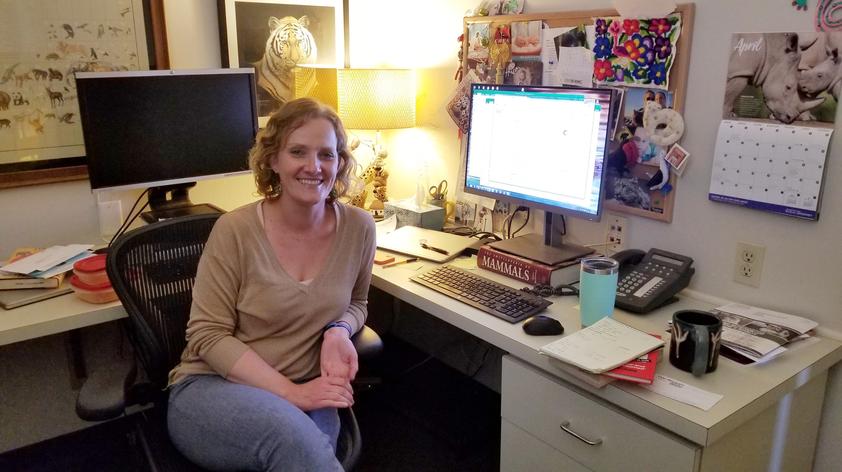
Pathology stories part four: A day in the life of Dr. Carmel Witte
The office is dominated by file cabinets and a computer desk, with photos of family as well as notes and books and images of favorite animals. The split computer screens are filled with spreadsheets of data and writing. This is the workspace of Dr. Carmel Witte, the resident epidemiologist in Disease Investigations.
Carmel arrives at the office after starting the morning with her family, where she keeps a running list of ongoing projects that need attention each day. Her job is no simple task, but rather to write programs to comb through immense data banks in order to isolate specific information related to population-level disease.
One of only a handful of epidemiologists working in zoos worldwide, her job is vital to the success of many of the conservation projects and research being done through the San Diego Zoo Global (SDZG). Her routine changes daily, but might include everything from data analysis or data review to working on papers she is submitting for publication. She might be preparing a lecture or designing a study for summer students. She might be compiling a literature review or researching workshops. No two days are the same, but she dives into her work in a way that allows her to examine each thing with methodical care.
When asked what her favorite parts of the job are, Carmel has two.
The first is the unique quality of working with a variety of species. Most epidemiologists study a particular species or disease throughout their careers, but through Disease Investigations, she has the chance to experience the true breadth of the field.
The other thing she loves is the problem-solving aspect. “We are taking real data and observations,” she says. “[We’re] trying to make sense of it with statistical tests and study designs and subsetting to better data.” This problem solving is what keeps her engaged, and always digging deeper into the data to find solutions.
Her path to Disease Investigations, like her job, is unique.
Unlike many of her colleagues who have backgrounds in veterinary medicine or animal care, Carmel came to epidemiology thanks to foundations laid in her undergraduate career. Even as a freshman, she knew she wanted to work with animals, and was part of a program focused on ecology and evolution. While exploring internships and other similar opportunities, she found a fellowship through Howard Hughes Undergraduate Research Program. She was taken on by a veterinary epidemiologist who started her on the path to that career. Her first project was related to potential crossover in raccoons and collection animals at a zoological institution, a project which she continued throughout her undergraduate career.
As Carmel was finishing her master’s degree, a fellowship opened at the San Diego Zoo (SDZ). She had SDZ on her radar since she was four years old and learned the Zoo had koalas, so when the opportunity presented itself, she jumped at the chance. She’s been here ever since. One of her large ongoing projects at the Zoo involves avian mycobacteria, a disease impacting birds and that has required a huge amount of data collection and analysis. You can read a little of her research into the disease here. While the disease has always been thought of as passed from individual to individual, research is also beginning to look at environmental factors. These environmental factors and patterns of the disease are where Carmel steps in.
One of the unique perspectives that Carmel brings to the Disease Investigations team comes through her Ph.D. in public health and her experience in zoonoses (animal diseases) that cross over between humans and other animals. Because she can see things from a human perspective, it gives her another insight into the spread of disease between species. This perspective also allows her to see disease through the lens of a social network, where the people or animals an individual spends time with can potentially be used to predict the spread and outbreak of disease.
Carmel’s skills and perspective create the scaffolding of the pathological research conducted at the zoo, making sense of raw data and observations to solve population-level mysteries of how diseases spread. “There’s an art to working with data,” she says. “It’s like you are having to connect the dots while also thinking three steps ahead.” She is a master puzzle-solver, finding just the right pieces through careful data analysis that can provide answers to all kinds of animal health questions, solving the mysteries that can help predict and mitigate disease, one analysis at a time.
Thanks very much to Dr. Carmel Witte for taking the time to chat with me and for sharing about her current and ongoing projects. You can learn more about Dr. Witte’s work through her profile on the Institute for Conservation Research website. You can read more of her research on her ResearchGate profile.
Joanna Volavka is a Graduate Student, Advanced Inquiry Program (AIP).













